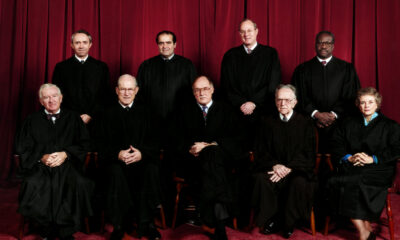Constitution
Supreme Court and Constitution under attack
The United States Supreme Court as an institution is under attack as never before. Today this attack comes from the Democratic Party – but it also comes from at least one of its own members. This tells us the low regard that too many people – even judges and Justices – have for the U.S. Constitution. The Constitution is the legal basis for the existence of the national judiciary, including the Supreme Court. But too many people respect only the basic framework of the Constitution – what powers it vests in what institutions – and none of the explicit restraints the Constitution places on the exercises of the powers it so vests. Some might say this hazard has always plagued the Court. But this hazard is worse today than ever – and if the people want their Constitution, they must prepare to defend it, by any means both necessary and effective.
Latest examples of attacks on (and from within) the Supreme Court
As everyone knows, the two prime (and older) members of the Originalist Bloc of the Supreme Court have come under the strongest – and most scathing – attack. Clarence Thomas stands accused of accepting gifts from a family friend who, his detractors say, is protecting an ideological interest. Simply put, both Thomas and his apparent benefactor are to the right of center. Recently Justice Samuel A. Alito’s wife got into a political spat with a neighbor. In reply, she controversially flew a United States flag, inverted, then the Appeal to Heaven flag from the American Revolution. This has provoked calls for him to abstain from all cases involving those under detention over the January 6 Event. One such call came from a sitting federal district judge in Massachusetts. Another came from Citizens for Responsibility and Ethics in Washington (CREW).
But an even worse attack now comes from a Court member: Justice Sonia Sotomayor. Yesterday in The Daily Mail she said she often shuts herself up in her chambers and weeps on the strength of “conservative,” i.e. Originalist, rulings.
Cullen Lineberger cited that in The Gateway Pundit and also mentioned that Sotomayor has done this before. The last time, she said it to an audience at the School of Law, University of California, Berkeley. The Hill quoted her speech, including this most disturbing excerpt:
Change never happens on its own. Change happens because people care about moving the arc of the universe towards justice. It’s your turn now, to carry that burden.
More recently, Rep. Hakeem Jeffries (D-N.Y.), House Democratic Leader, called on Congress to “control” the Originalist Bloc and their occasional allies the Moderates.
Critical Legal Studies
These spectacles might, according to one Republican National Committeeman, reflect the influence of a movement, during the 1970s, called Critical Legal Studies. Critical Legal Studies, like all Critical movements, finds fault with its subject, in this case, the law. A key leftist movement in America’s law schools, Critical Legal Studies held that:
- Statutes and court rules make legal results indeterminate, so that a judicial ruling results from a judge’s ideological animus,
- The law benefits certain groups and institutions that happen to hold the most power at the time of controversy,
- Judges and lawyers typically throw up clouds of terminology to make their decisions and holdings seem reasonable and logical, and
- Social justice requires letting “new or previously disfavored social visions” “win” for a change.
The “Too Long; Don’t Read” version of the above is: all law is politics. And not law only, but Constitutions also. According to Critical Legal Studies, the law can never be neutral.
But the proponents of this theory undermine their own arguments with their emotion-fraught commentary on Constitutional rulings. When they decry a ruling like, say, Dobbs v. Jackson Women’s Health Organization, they pretend that the Supreme Court, in finding as they did, somehow violated the Constitution. But if the Constitution is indeterminate, then they have no argument. How can they charge a violation of a principle that, they have previously held, does not even exist? Behold their “Living Constitution” argument, and its logical endgame!
The shoe is squeezing the other foot
Besides, the Supreme Court, in Roe v. Wade, indulged in exactly the sort of behavior Critical Legal Students decry. It introduced the word penumbra to stand for a kind of unwritten corollary to the Bill of Rights. By that device they “found” a “right” to abortion in the Constitution. Justice Alito, in Dobbs, laughed that idea to scorn, and properly so. But, like their predecessors on the Roe Court, the three dissenters wrote what reads like a script for a rear-guard action against an advancing – and avenging – army.
Sadly, this kind of flawed analysis has plagued the Supreme Court before. One can read it in Dred Scott v. Sandford and the notorious Plessy v. Ferguson. But here, Critical Legal Studies falsifies itself. In those thoroughly awful decisions – Dred Scott, Plessy, and Roe – the Justices involved threw all logic aside and simply stated their ideologies, up-front. Chief Justice Roger B. Taney, writing for the court in Scott, raised the spectacle of (horrors!) armed blacks. To a section of the country with fresh memories of Nat Turner’s Rebellion and Harper’s Ferry, that was red meat. In fact it started a war.
The attacks on the Supreme Court continue
The Daily Mail cited, and briefly quoted, a March op-ed in The Atlantic by editorial contributor Josh Barro. He cited Sotomayor’s poor health – in fact she’s a diabetic who must have a doctor in attendance when traveling. She is 69 years old, and, according to Barro, should retire as soon as possible. Otherwise, he says, the “conservative majority” will grow from six members to seven. (Trump’s record of Court appointments consists of replacing one Originalist by another, one Moderate by another, and – the key – one Liberal with a Moderate. So either the Moderate Bloc or the Originalist Bloc will grow to four, depending on the quality of Court nominating advice Donald Trump gets.)
These quotes of Barro by The Daily Mail show how infused with Critical Legal Studies Barro is:
You’re worried about putting control of the Court completely out of reach for more than a generation, but because she is Latina, you can’t hurry along an official who’s putting your entire policy project at risk? If this is how the Democratic Party, operates, it deserves to lose.
And:
[If she doesn’t retire this year, she’ll be] making a bet that she will remain fit to serve until possibly age 78 or even age 82 or 84 – and she’ll be forcing the whole Democratic Party to make that high-stakes bet with her.
That sounds as though he’s afraid Trump will not only win but also pass the torch to a Republican successor. But this is arguably the worst:
I thought Democrats had learned a lesson from the Ruth Bader Ginsburg episode about the importance of playing defense on a Court where you don’t hold the majority.
All liberals have to show for this stubbornness is a bunch of dissents and kitsch home décor.
Lay aside the (lack of) quality of those dissents. This is the language of a fanatical cultural-Marxist would-be destroyer, not a friend of Constitutional government. The bad news is that Sonia Sotomayor shares with Barro the same contempt for the Constitution, and results-oriented attitude. CNAV has noted time and again that she and Justices Ketanji Brown Jackson and Elena Kagan routinely treat the Supreme Court as if it were a court of equity, not law. The good news is that she seems to share the late Justice Ruth Bader Ginsburg’s stubbornness.
Badly needed reform
If this is the caliber of lawyers and judges coming out of law schools today, then those schools badly need systematic, top-down reform. The Constitution sets forth protections of life, liberty and property. Furthermore the Constitution should be readable as determinate.
Thomas Jefferson famously worried about the Supreme Court “shap[ing] and mold[ing]” the Constitution as if it were made of wax. Clearly Sotomayor – and Jackson and Kagan – would like to so shape and mold the Constitution. Equally clearly, people like Jeffries and Barro want to see that happen – and resent the efforts of Originalists to reshape and re-mold the Constitution back to the way it should be, correcting the errors the Supreme Court made under Justices like Earl Warren and Warren Burger. Sometimes the Court under one or both men corrected earlier errors of the opposite kind. But other times they went from one extreme to the other.
Ideally, Justices Jackson, Kagan and Sotomayor rate removal from the bench on impeachment for, and conviction of, contempt for the Constitution. Failing that, appointing another Originalist to replace Sotomayor would be a good start. (She’s the least temperate of the Court’s members, and might rate removal just for one of her temperamental outbursts. And that’s assuming she didn’t perpetrate the Great Leak of the Dobbs opinion.) But above all, the people must elect a President and Senate with the proper respect for the Constitution. They then need to reform the entire judiciary, one judge or Justice at a time.
Terry A. Hurlbut has been a student of politics, philosophy, and science for more than 35 years. He is a graduate of Yale College and has served as a physician-level laboratory administrator in a 250-bed community hospital. He also is a serious student of the Bible, is conversant in its two primary original languages, and has followed the creation-science movement closely since 1993.
-

 Civilization3 days ago
Civilization3 days agoDC Pipe Bomb Arrest Raises Questions About Christopher’s Wray’s FBI
-

 Civilization4 days ago
Civilization4 days agoThe Legal Logic Behind U.S. Operations Against Narco-Terrorist Networks
-

 Executive4 days ago
Executive4 days agoNewsom’s ‘National Model’ for Homeless Wracked by Fraud
-

 Executive3 days ago
Executive3 days agoWhen You’re in a Hole, Stop Digging
-

 Education3 days ago
Education3 days agoWaste of the Day: Taxpayers Subsidize Football Coach Severance
-

 Executive2 days ago
Executive2 days agoWaste of the Day: Obamacare Failed Test, Approved Fraudulent Subsidies
-

 Civilization2 days ago
Civilization2 days agoPence Calls on Trump To Fire RFK Jr Over Abortion Drug
-

 Executive4 days ago
Executive4 days agoWaste of the Day: Feds Pay Nonprofits That Sue the Government










